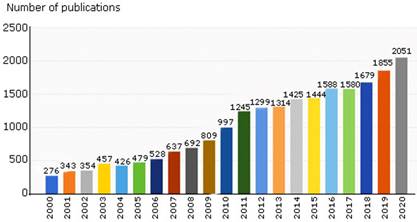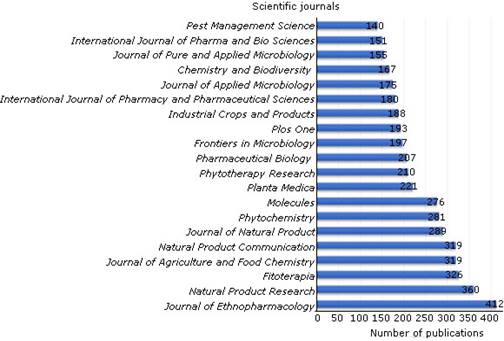Introduction
Natural products (NPs) are an essential and reliable source of cutting-edge compounds in pharmacology. For millennia, medicinal plants have been their most valuable source and still many of today’s drugs are therapeutic agents obtained from their extracts or derivatives.1,2 Natural products are structurally “optimized” by evolutionary processes fulfilling particular biological functions, including endogenous defense mechanisms and interactions (often competition) with other organisms, which explains their great relevance for pharmacotherapy, especially in the areas of cancer and infectious diseases.3
Fungal infections represent a major health problem, with mortality rates comparable to those of tuberculosis or malaria, and frequently occurring in patients whose immune systems are compromised.4 However, only a few classes of antifungal drugs are currently available to treat such infections.5,6 The vast majority of the new approved antifungal drugs belong to two large groups, the azoles, and the echinocandins, which together with the polyenes (like amphotericin B), are the only classes of antifungal agents capable of treating severe fungal infections.6 This low number of chemical structures (and associated mechanisms) as well as the low number of antifungals approved annually is evidence of the need to find new molecules capable of meeting the demand for this type of drug. In this context, natural plant derivatives constitute a promising resource available to the scientific community.
To deem if the Plantae kingdom can be a source of antifungal compounds, it would be necessary to know the behavior of the scientific production on compounds with antifungal activity derived from plants. To this end, bibliometrics is taken as a support to identify trends and irregularities in scientific production,7 and bibliometric network maps as science visualization tools.8
To understand the structure of the research domain on antifungals from plants, the co-occurrence of keywords was employed. Keywords co-occurrence networks have been extensively studied; the number of co-occurrences of two words indicates the number of publications in which both words occur in the list of keywords.8 These analyses are very useful to identify the thematic structure in the research domain under study. Bibliometric studies regarding the specific topic were not found in the literature and similar studies only address either fungal diseases,9 or specific fungi10 or antifungal compounds and the resistance of some fungi to them.11
Therefore, the present research aimed to analyze the world scientific production on antifungals compounds from plants, performing a bibliometric analysis considering all manuscripts indexed by Scopus in the period 2000-2020. And to highlight the Cuban scientific production on the topic, Cuban publications were selected as a case study.
Methods
The bibliometric analysis carried out can be divided into three fundamental parts:
Data collection and methodology: To collect raw data, we used the journal database exported from Scopus online database (https://www.scopus.com). Based on the research framework, we composed our query searching for the codeword’s “antifungal” (= antifung *; anti-fung *) plus “plant” appearance in the title, abstract, and/or keyword sections. The search was restricted to all papers published from 2000 to 2020. The data retrieval was implemented in December 2021, and 24 084 publications were initially searched (64 in the case study of Cuban publications). The bibliometric data of title, author name, publication year, journal, author keywords, and abstract were retrieved.
Dataset pre-processing and refinement: The data exported from Scopus was pre-processed and cleaned using OpenRefine tool (available at https://openrefine.org). Data refinement and normalization were conducted to compose synonym text sets that indicate the same meanings (e.g., antifungal and anti-fungal), unify singular and plural of same words to the singular words, and reflect academic compound noun based on the author keywords data. The refinement results were accepted, so 31 935 keywords of 24 084 publications were selected for the following steps (1003 keywords of the 64 Cuban publications).
Analysis strategies: Cleaned data was imported into the VOSviewer software (CWTS, University of Leiden, Leiden, Netherlands) for keyword-based bibliometric analysis.12 The 5000 most common words from the Corpus of Contemporary American English (retrieved from https://www.wordfrequency.info/free.asp?s=y) were excluded using the thesaurus function of the software. A co-occurrence analysis was performed taking into account only the keywords presented by the article’s authors, using the complete count method and considering 25 as the minimum number of occurrences by keyword (three in the case study of Cuban publications, due to the low total amount). All graphics were constructed from data helped by MS Excel from the MS Office package on Windows (Microsoft Corporation, 2019).
Results and discussion
A total of 24 084 publications were identified and analyzed by the bibliometric study, demonstrating a growing interest year after year by the scientific community in the subject analyzed (figure 1). A quick statistical analysis of the data showed that the annual increment fit a linear regression. The linear equation, with an R square value of 0.97, is Y = 89.46*X - 178794, which predicts a number of publications on the subject equal or greater to 2000 for the year 2021.
Of all the processed documents, 85.8% were original articles and 9.6% were reviews. The remaining 4.6% included 416 book chapters, 388 conference papers, 84 short surveys, among other documents. Almost the third part corresponds to open access documents (7720, 32.1%), while the most active authors were Tzibun NG (Chinese University of Hong Kong, Shatin, Hong Kong, with 139 hits) and Hostettmann K (University of Geneva, Geneva, Switzerland, with 105 hits). The main subject areas were: Biochemistry, Genetics and Molecular Biology (n = 8988), Biological and Agricultural Sciences (n = 8152), Pharmacology, Toxicology and Pharmaceutical (n = 7580), Medicine (n = 5397) and Chemistry (n = 3989). Considering the origin of the authors, the most prominent countries were: India (n = 4453), China (n = 2753), United States (n = 2230), Brazil (n = 1471), and Italy (n = 1008) accounting for almost 50% of the total number of scientific papers processed (fig. 2) showing how polarized the subject matter analyzed is in the world.
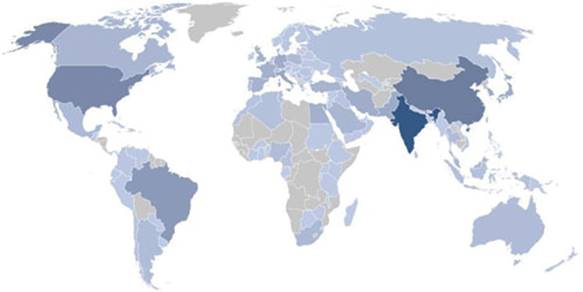
Fig. 2 Countries by total number of publications during the period 2000-2020 (the greycolor groups countries with less than 8 publications).
In current science metrics, the type of journal and its impact factor play an important role in the visibility of results. In this context, the Journals of Ethnopharmacology (IF 4.36, n = 412), Natural Product Research (IF 2.86, n = 360), and Fitoterapia (IF 2.88, n = 326) score the highest number of hits. Figure 3 shows the top 20 journals used by scientists to disseminate results obtained in the search for plant-derived substances with antifungal activity. Even so, these twenty journals only cover approximately 20% of the total number of papers published, showing the wide range of journals covering this topic.
VOSviewer extracts and analyses the words in the titles and abstracts of the publications, relates them to the citation count, and finally visualizes the results as a bubble map.13 The size of the term map bubble (fig. 4) indicates the frequency of occurrence of the words (multiple occurrences in a single post count as one). The color of the bubble indicates the average citation count received by posts that contain the word in their titles or abstracts. Two bubbles are closer together if the two words have a more frequent match.14 The use of this software also made it possible to reduce the 31935 keywords declared by the authors in the 24 084 documents analyzed to 328 by considering their number of occurrences (fig. 4). The topics with higher citations included: “essential oils”, “antioxidant”, “medicinal plants”, “Candida albicans” and “flavonoids” with 1322, 678, 467, 455 and 325 records respectively. From this analysis it can be deduced that essential oils are the most widely used plant extracts as antifungal, that antioxidant capacity is the biological activity most co-studied with antifungal activity, that Candida albicans is the most common target micro-organism, and that flavonoids are the most studied secondary plant metabolites with this type of biological activity.
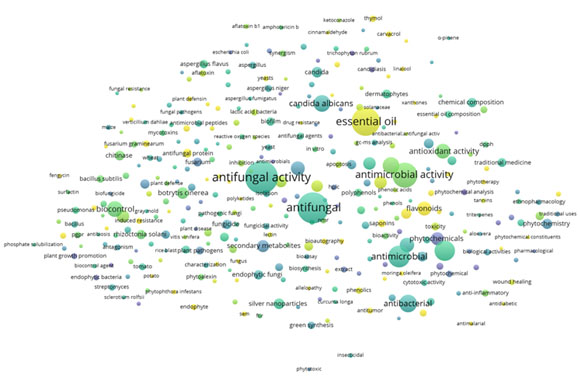
Fig. 4 Map of terms for publications related to antifungals and plants. The bubble map displays 328 terms that appeared in at least 25 of the included posts.
Antifungals from plants, Cuba as a case study: From the 24 084 global publications, 64 were published by Cubans authors in the analyzed time period. The low number of Cuban publications is the main limitation of the study carried out. The recovered scientific production was published in English, so it may not represent Cuban production on this subject, which is published mainly in Spanish. But, even taking that into account, Cuba occupies the 57th position on the country scale of this research topic.
Due to the low amount of Cuban annual publications, the yearly increment has been irregular compared to the global scale. In consequence, the total number of publications on a 5-year interval was analyzed. This strategy allowed us to see a more understandable panorama that agrees with the world trend tendency. Accumulated values of 5, 17, 18, and 24 (n = 64) in the periods 2000-2005, 2006-2010, 2011-2015 and 2016-2020 respectively; shows how the Cuban scientific community is also showing greater interest in the search for new antifungal plant extracts / substances.
Of all the Cubans entries, 58 (90.6%) were original articles, four (6.3%) were reviews and two (3.1%) were book chapters. With 21 entries (32.8%), Cuban authors make visible their researches in open access documents, keeping the worldwide tendency on this field when compared this 32.8% versus 32.1%. The most active Cuban authors were Osmany Cuesta-Rubio from Universidad de La Habana, Havana (five hits). Other with high activity were Mayra Acosta-Suárez (Universidad Central de Las Villas, Santa Clara), Lianet Monzote (Instituto de Medicina Tropical Pedro Kouri, Havana) and Julio César Escalona Arranz (Universidad de Oriente, Santiago de Cuba), with four hits each. This reflects a logical panorama, since these authors represent the largest Cuban universities and the iconic Pedro Kouri Institute, which at the same time concentrate the greatest material and human resources. The non-Cuban author with the highest number of hits (n = 7) was Paul Cos (Universiteit Antwerpen, Antwerp, Belgium); while Belgium was the country with the highest amount of hits per collaboration (n = 11; 17.2%), showing the extensive relationship between Cuba and Belgium on this and other related topics. The main subject areas were more or less the same as for the rest of the world with Agricultural and Biological Sciences (n = 26), Biochemistry, Genetics and Molecular Biology (n = 17), Immunology and Microbiology (n = 11) and Chemistry (n = 10) as the most represented.
Figure 3 was created to illustrate how the scientific community choose high-impact journals to visualize their researches. Taking into account the aforementioned top twenty influential journals by the total number of publications (fig. 3), Cuban authors have published 13 times (20.3%) on those high-impact magazines. Those values point out the same inclination of Cuban authors for publishing on those journals (20.3% vs. 19.78%). Nevertheless, local journals score a higher weight on the number of publications per journal, Revista Cubana de Plantas Medicinales (Editorial Ciencias Médicas, n = 7) and Biotecnologia Aplicada (Elfos Scientiae, n = 7) are the ones with the highest number of hits.
The VOSviewer analysis of the 64 documents reduced the 1033 keywords declared by Cuban authors into 100 by considering their number of occurrences (fig. 5). Topics with higher citations included: “Staphylococcus aureus”, “Candida albicans”, “plant leaf”, “antimicrobial activity”, “medicinal plants”, and “flavonoids” with 16, 14, 13, 13, and 6 records respectively. From this analysis it can be deduced that plant leaves are the most explored organs for antifungal research, that antimicrobial activity is the most co-studied biological activity with antifungal activity, that Staphylococcus aureus is the most common target microorganism and Candida albicans the most common target fungi, and that flavonoids are the most studied secondary plant metabolites with this type of biological activity.
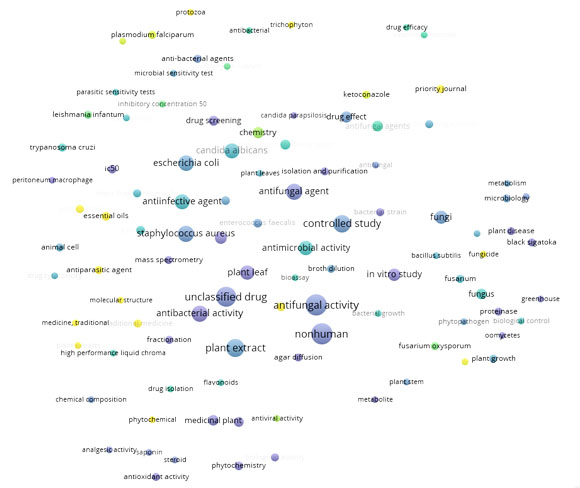
Fig. 5 Map of terms for Cuban publications related to antifungals and plants. The bubble map displays 100 terms that appeared in at least 3 of the included publications.
From the 64 Cuban publications, the most relevant according to their citations were:
Piper species: a comprehensive review on their phytochemistry, biological activities and applications (116 citations): A review article about the chemical composition, biological activity (including antifungal), and applications of plants from the genus Piper (including various native and introduced Cuban species of this genus).15
In vitro anti-microbial activity of the Cuban medicinal plants Simarouba glauca DC, Melaleuca leucadendron L and Artemisia absinthium L (44 citations): In this article, the antifungal activities of various Cuban plants were evaluated against Microsporum canis and Candida albicans.16
Aristophenones A and B. A New tautomeric pair of polyisoprenylated benzophenones from Garcinia aristata. (44 citations): The structural determination of two new isoprenylated benzophenones from Garcinia aristata, a plant with antimicrobial and antifungal activity.17
Antimicrobial activity of extracts from Tamarindus indica L. leaves (43 citations): Antimicrobial evaluation of Tamarindus indica L. growing in Cuba, including antifungal evaluation against Candida albicans.18
Efficacy of ozonized sunflower oil in the treatment of tinea pedis (39 citations): Evaluation of the efficacy of ozonized sunflower (Helianthus sp.) oil against the fungal infection caused by tinea pedis (athlete's foot).18
Conclusion
In the last two decades (2000-2020), the number of new publications related to plants as antifungals has increased significantly, from 276 to 2051 publications, expecting more than 2000 for the year 2021. These results prove that the scientific community is interested on the topic, further demonstrating that plants could become a reliable source of antifungal drugs. Cuba and their researchers (as case study country) did not differ in those finding described for the rest of the world, indicating their alignment with this world tendency.














